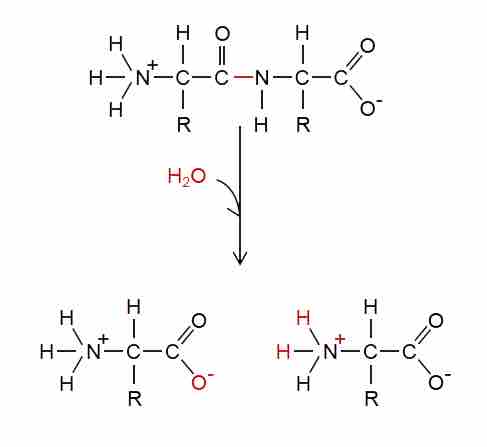Hydrolysis
Polymers are broken down into monomers in a process known as hydrolysis, which means "to split water," a reaction in which a water molecule is used during the breakdown . During these reactions, the polymer is broken into two components. If the components are un-ionized, one part gains a hydrogen atom (H-) and the other gains a hydroxyl group (OH–) from a split water molecule. This is what happens when monosaccharides are released from complex carbohydrates via hydrolysis.

Hydrolysis reaction generating un-ionized products.
In the hydrolysis reaction shown here, the disaccharide maltose is broken down to form two glucose monomers with the addition of a water molecule. One glucose gets a hydroxyl group at the site of the former covalent bond, the other glucose gets a hydrogen atom. This is the reverse of the dehydration synthesis reaction joining these two monomers.
If the components are ionized after the split, one part gains two hydrogen atoms and a positive charge, the other part gains an oxygen atom and a negative charge. This is what happens when amino acids are released from protein chains via hydrolysis.

Hydrolysis reaction generating ionized products.
In the hydrolysis reaction shown here, the dipeptide is broken down to form two ionized amino acids with the addition of a water molecule. One amino acid gets an oxygen atom and a negative charge, the other amino acid gets two hydrogen atoms and a positive charge. This is the reverse of the dehydration synthesis reaction joining these two monomers.
These reactions are in contrast to dehydration synthesis (also known as condensation) reactions. In dehydration synthesis reactions, a water molecule is formed as a result of generating a covalent bond between two monomeric components in a larger polymer. In hydrolysis reactions, a water molecule is consumed as a result of breaking the covalent bond holding together two components of a polymer.
Dehydration and hydrolysis reactions are chemical reactions that are catalyzed, or "sped up," by specific enzymes; dehydration reactions involve the formation of new bonds, requiring energy, while hydrolysis reactions break bonds and release energy.
In our bodies, food is first hydrolyzed, or broken down, into smaller molecules by catalytic enzymes in the digestive tract. This allows for easy absorption of nutrients by cells in the intestine. Each macromolecule is broken down by a specific enzyme. For instance, carbohydrates are broken down by amylase, sucrase, lactase, or maltase. Proteins are broken down by the enzymes trypsin, pepsin, peptidase and others. Lipids are broken down by lipases. Once the smaller metabolites that result from these hydrolytic enzymezes are absorbed by cells in the body, they are further broken down by other enzymes. The breakdown of these macromolecules is an overall energy-releasing process and provides energy for cellular activities.